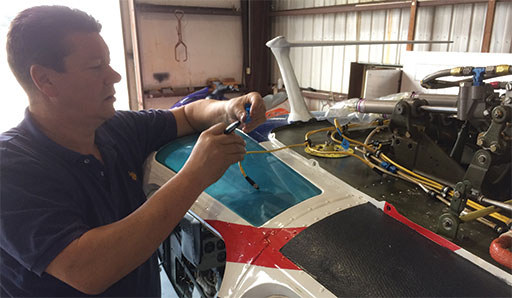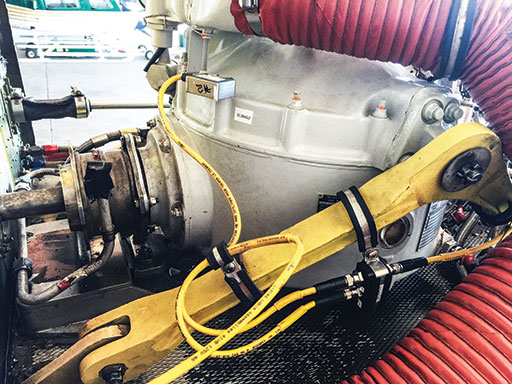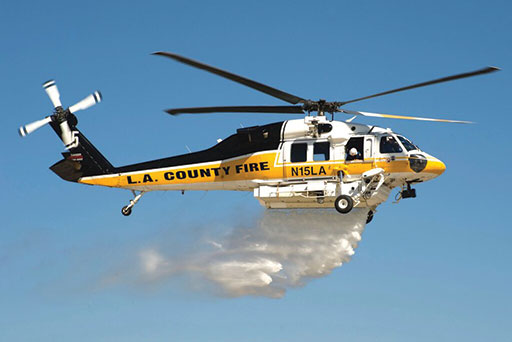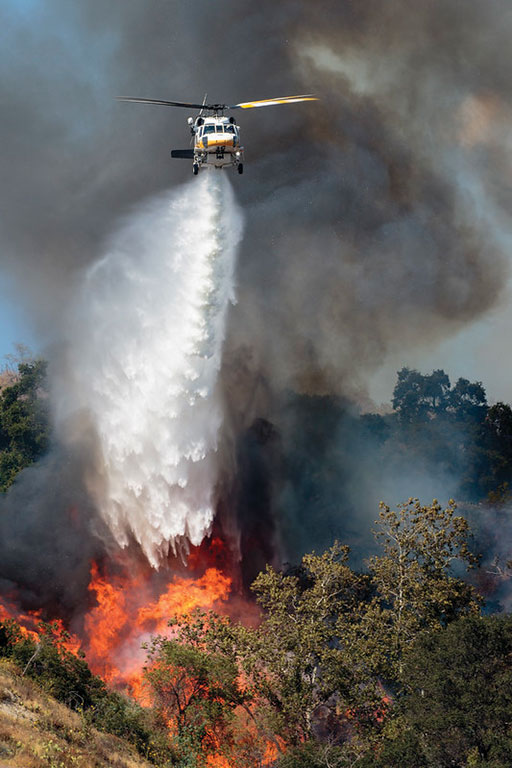A T-shirt definition of the word “helicopter” reads that the aircraft is: “A million parts rotating rapidly around an oil leak waiting for metal fatigue to set in.” While it may be a bit of an exaggeration, there are few machines in the world with so many rapidly spinning components—components that, when they spin erroneously, can cause catastrophic failures. Monitoring these components has been the job of helicopter Health and Usage and Monitoring Systems (HUMS). Born from tragedy over 30 years ago, HUMS has come a long way.
On November 6, 1986, British Airways Helicopters Boeing 234LR Chinook G-BWFC crashed into the North Sea near the Shetland Islands with the loss of 45 passengers and crew when a forward transmission gear failed and synchronization between the forward and aft rotor systems was lost. The crash investigation highlighted the fact that the aircraft lacked the ability to continuously monitor dynamic component performance aside from traditional flight instrumentation. History today tells us that those 45 souls were not lost in vain as this crash was the catalyst for the development of HUMS.


In the cockpit of a helo, fluctuations in oil pressure and an increase in operating temps, or even a chip light could be the sign of a dynamic component that is moments from failure whereas subtle vibrations, undetectable by flight crews and standard flight instrumentation, and possibly not even detectable by legacy maintenance check flight systems, can telegraph a component failure long before pilots would ever need to start emergency procedures. In helicopter aviation, HUMS exists to keep operators and maintainers apprised of aircraft health at previously unattainable levels. This data can not only prevent emergencies, but, in a more immediate service, HUMS saves operating costs by allowing maintainers to identify components that will need replacing with greater lead time allowing the acquisition of parts that leads to shorter down time for the aircraft.
Since first being introduced to larger oil and gas field helicopters in the 1990s, HUMS has only gotten better and better and has found its way into the light/single helo market as well.
New and Improved
Early HUMS systems experienced teething issues. According to Green Power Monitoring Systems (GPMS) co-founder and chief engineer, Eric Bechhoefer, a HUMS manufacturer for light helicopters, early HUMS “were good in concept but clunky in execution. They were heavy, expensive, challenging to use, and prone to false positives. For instance, alerts regarding a possible bearing fault that triggered a main gearbox disassembly, and then turned out to be nothing created mistrust of the system among maintainers.” Today’s GPMS HUMS feature a patented method of signal filtering to reduce false positives as well as proprietary cloud-based algorithms that improve fault detection.
It is important to note that when HUMS is installed, analysis can begin immediately—even without historical data. Kenneth Speaks of HUMS pioneer RMCI says that on their very first installation on a Sikorsky S-70, because of the accuracy of their software algorithms, they were able “to identify issues with the aircraft immediately and not based on data trends.”
Expanded Monitoring
Helicopter manufacturer, Leonardo includes HUMS as standard equipment on all of their new AW Family aircraft. Traditional HUMS systems monitored engine, transmission, gearbox vibration, and rotor track-and-balance, but Leonardo’s latest HUMS has, according to company spokesperson Margaret Rogalski, has “added monitoring capabilities of additional components, such as the swashplate. The system is in an active state of continuous development and improvement which, in addition to updates to the algorithms used by the system to improve the monitoring accuracy and to reduce the false alarms rate, was able to increase the number of components monitored on the AW139 model with the addition of a sensor dedicated to the oil cooler fan monitoring.” Their “real-time HUMS” system sends alerts directly to ground maintenance if issues arise.
Collins Aerospace’s Kevin Hawko shares that their systems have gone way past the original HUMS designs to include monitoring couplings and shafts, determining recommended adjustments for rotor track and balance, verifying engine performance and automated power assurance checks, watching aircraft operating limit exceedances—speed, torque, power, angle of bank, (engine) pressure/temperature—aircraft flight regimes—climbs/descents, angle of bank, rate of turn, altitude, airspeed—cockpit voice/flight data, and aircraft system or airframe sensing (strain, pressure, temp, speed, vibration, etc.).


RMCI’s Speaks says that customers have regularly requested the expansion of traditional HUMS monitoring parameters to include things like in-line fluid debris monitoring and, for one heli-logging specialist, load sensors that not only measure the weight of the slung cargo, but that also records a GPS position and time/date stamp of every load lift and drop. RMCI currently builds and installs HUMS in more than a dozen helicopter types.
Light Helo Market
HUMS was originally envisioned for the heavy helicopters of the oil and gas fields. Also, larger military helicopters, with power to spare, was a natural fit for early HUMS systems that were not always small or lightweight. With decades of HUMS success, builders of today’s light helos are including HUMS in their standard equipment packages and HUMS manufacturers are targeting the light helo market to retrofit in-service aircraft. New technology allows HUMS installers to enjoy the benefits of smaller footprints and lighter-weight systems—always crucial in light helicopters that seem to always be short on space and overweight.
HUMS manufacturer, United Electronic Industries (UEI) installs HUMS on U. S. Air Force helicopters. Illustrating the terrestrial reach of HUMS, they also have systems on city buses with hybrid powerplants. UEI’s Bob Judd shared that the company recently installed a 20 lb. HUMS on Bell UH-1N Huey helicopters “where our system needed to be deployed under the floorboards, in the back cabin and crammed in between various control rods that run under the floor.”
RMCI also targets the light helo market and has a system for MD helicopters weighing in at five lbs. The company, according to Speaks, is looking to provide HUMS to “anyone that flies,” including fixed-wing operators that are looking for power plant monitoring, turboprop gearbox analysis, as well as airframe stress and load monitoring.
GPMS’s Bechhoefer says that their nine lb. light/single helicopter system can be installed by qualified A&P mechanics in 60-80 hours.
Modern Electronics and User Interfaces
Data storage for early 1990’s-vintage HUMS systems was a challenge, but not so today. Rugged solid state drives with exponentially more data storage are widely available and far less expensive than storage of years past. UEI’s UH-1N system uses modern SD data cards and features USB 2.0 ports. Many early HUMS systems, especially in military aircraft, are still using PCMCIA cards for data and many legacy HUMS systems required physical downloading following a sortie. Today’s HUMS can communicate wirelessly through WiFi and GSM (cellular) connections to send data to maintenance facilities, as well as the aircraft’s manufacturer in real time. Additionally, if the aircraft is being flown outside of cellular range, the system can store up to 1000 hours of operating data for later analysis.
Leonardo’s “real time HUMS” introduced recently “allows selected alarms generated during the flight to be immediately sent on ground. The real time analysis performed will allow the preparation of the needed tools for the ground maintenance before the landing of the [aircraft], further reducing the downtime,” according to Rogalski.
Another needed improvement for HUMS was in the user interface world. Original systems downloaded to dedicated desktop computer systems. Today, HUMS data from most systems is available in easy-to-interpret presentations on customer’s smart phones and tablets as well as laptops. With data being sent via cellular networks or satellites, operators and maintainers can literally monitor aircraft from the kitchen table on an iPhone.

Cost Reductions
UEI’s Bob Judd says, “More and more customers are investing the time and cost for extensive HUMS capability now as they realize the upfront cost of a HUMS system can be small relative to the savings in preventive maintenance and lost productivity caused by unpredicted failures.”
Honeywell Aerospace reports that their current customers have shown a 30 percent reduction in flight cancelations, a 20 percent reduction in required test flights and a 5-10 percent reduction in scheduled maintenance. “A low-cost HUMS system is on the roadmap to address system affordability,” Paul Paulson, senior sales manager for HUMS at Honeywell says. “We have been told by some OEMs that they would put HUMS on every aircraft if a lower-cost offering was available, so we’re working to provide that.”
RMCI was able to use HUMS data for a customer to prove that a transmission problem in an aircraft was not caused by the customer’s maintenance, but was traceable back through the aircraft service’s life. This allowed the customer to get a transmission replaced under warranty as opposed to having to pay for a replacement out-of-pocket—a huge savings attributable directly to HUMS monitoring.
Expanded Data Analysis and Fleet Data Analysis
A continuing area of improvement in the HUMS world is in data analysis—especially in realizing the benefits of fleet HUMS data analysis.
When it comes to small operators of light helos, GPMS’s Bechhoefer says, “Maintenance of aircraft is largely done in silos and operators have limited understanding of how other similar aircraft are used or maintained. Could HUMS systems provide more fleet wide data on say, an emerging bearing issue, as well as opportunities for operator to operator collaboration? We think so.”
Airbus’s HUMS combines their Helionix software with their new FlyScan service that provides data analysis for a single ship or entire fleet of aircraft provided directly by Airbus so that an operator does not have to employ HUMS-dedicated personnel.
In a profound example of the benefits of HUMS fleet data analysis, RMCI tells the story of a military customer who, when detecting an anomaly in the data from an aircraft, was considering a world-wide grounding of an entire fleet of combat helicopters. RMCI looked at the collective fleet data and was able to not only identify that only several aircraft were effected by the issue but “we saw that the problem aircraft were in a batch of consecutive serial numbers,” says Speaks, “showing that someone probably had a bad week on the factory floor.” Because RMCI was able to determine that the problem was not a fleet-wide issue, there was no need to ground the fleet.
Todd Vorenkamp is a former U. S. Navy and U. S. Coast Guard aviator who has flown as an aircraft commander in the Boeing CH-46D Seaknight, Sikorsky UH-3H Sea King, Sikorsky MH-60S Knighthawk, and Airbus MH-65C Dolphin helicopters. He is a graduate of the U. S. Merchant Marine Academy and has a Master of Fine Art Photography from the Academy of Art University.
